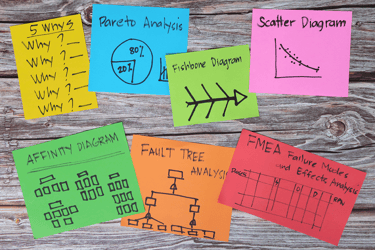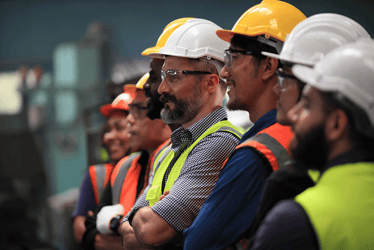The Packaging Industry's Sustainability Challenge: Why ERP Systems Are Essential for Success A straightforward guide to navigating sustainability regulations across folding carton, flexible...
Practical Ways Converting Companies Can Leverage Generative AI
My previous article, Exploring AI Technologies for Manufacturing: A Primer for Converters, introduced the role of AI technologies, particularly the rise of Generative AI (GenAI), and how it could impact manufacturing.
Today, I want to take this discussion a step further by focusing on practical, easy-to-implement ways that converting companies can leverage GenAI, with real-world use cases that deliver immediate value.
Suppose you're a senior manager looking to drive efficiency and clarity in your business. In that case, these suggestions might be exactly what you need to get you thinking about possibilities and practical projects.
Let’s dive into two simple examples Generative AI has been applied at a few converting companies:
1. Creating Standard Operating Procedures (SOPs) for Manufacturing
An SOP, or Standard Operating Procedure, is a detailed, step-by-step guide that outlines how to perform specific tasks or operations in your company. For manufacturing, SOPs are essential to ensure consistency, quality, and safety across the production process. They provide employees with a clear understanding of how to operate equipment or carry out procedures correctly, reducing errors and improving efficiency.
Creating and updating SOPs is a time-consuming process, especially in complex manufacturing environments like a printing press, is never an easy process. Further, when implementing a new ERP or shopfloor system, these need to be updated. Many companies have not updated or used their SOPs for decades, and during implementation, they are not easily found or incomplete. The prospect of re-writing complex updated SOPs for each major cost center is a daunting task, so we used GenAI to help recreate the “current state” SOPs as a starting point.
Here’s an example of a simple strategy to streamline SOP creation:
- Set up a meeting: Gather your SMEs and hold an online meeting using Microsoft Teams or a similar tool. The team will discuss the operation and maintenance of a complex machine, such as a printing press.
- Record and transcribe the meeting: Use built-in transcription tools (Teams offers this feature) to automatically convert the meeting into text.
- Feed the transcription to ChatGPT or Copilot: Ask the AI to generate a one-page SOP from the transcribed content. You can further refine the output by requesting specific details, clarifications, or updates.
This process dramatically reduces the time spent creating SOPs and ensures that the resulting documents are concise, accurate, and easy to update in the future. Plus, because ChatGPT and Copilot can refine their output based on feedback, continuous improvements are easy.
2. Creating an HR Policy
This use case comes directly from Jeff Putt, Managing Director – Digital Services at DeLine Box & Display in Denver, Colorado. Jeff’s team recently implemented GenAI to streamline their HR policy management—and the results speak for themselves.
HR policies often evolve organically over time, leading to scattered documentation and outdated manuals. GenAI can help consolidate, organize, and simplify this process. Here’s how they did it:
- Collect all relevant HR documents: Jeff's team gathered the Employee Handbook, 401K documents, and their Benefits Package promotional documentation. This included documents stored in multiple locations, ranging from emails to PDFs.
- Upload the documents to ChatGPT or Copilot: They used the AI to handle multiple documents at once, analyzing the content to generate a summarized HR policy resource, benefits package and 401K GPT that consolidated and updated the key points from all three information sources.
- Resolve conflicting information: During the training period, responses that were incorrect compared to policies or contained extraneous (hallucinated) information, were prompted to only utilize the 3 documents and not stray from the information within. This assured that no “elaboration” by the GPT occurred. The idea is to have a handy resource for managers to get quick answers to many HR questions in real time. The GPT can even be queried to tell users what page in the manuals the topic can be found for verification, if needed.
"The entire process was remarkably easy. We uploaded everything in minutes and had a working draft of our HR manual by the end of the day. We then spent a few days verifying and retraining the GPT. What used to take weeks was now finished in hours."
Jeff Putt, Managing Director – Digital Services at DeLine Box & Display
Suggested Next Steps
Ready to try GenAI in your business? Here are a few practical steps to get you moving:
- Start with a pilot project: Select one key area—like SOP creation or HR policy management—to test how AI can make your processes more efficient.
- Train your team: AI tools like ChatGPT and Copilot are user-friendly, but a little training goes a long way. Consider a short workshop for key staff members to familiarize them with these tools.
- Gather feedback and refine: AI-generated documents will need refinement, but this process gets faster with each iteration. Gather input from your team to make sure the output is practical and accurate.
- Think bigger: Once you've seen success with smaller projects, consider using AI for other tasks—such as automating customer service responses, predicting maintenance needs, or even forecasting sales patterns based on historical data.
My experience has been to use these tools as a great starting point, then have teams collaborate, validate, and to do further research and finalize. Generative AI is a powerful tool, and these examples just scratch the surface of what's possible. By starting small, you'll build the foundation for a more efficient, future-proof business.
Let's keep the conversation going—how do you envision using GenAI in your operations? Feel free to connect with me to explore more use cases tailored to your needs.



